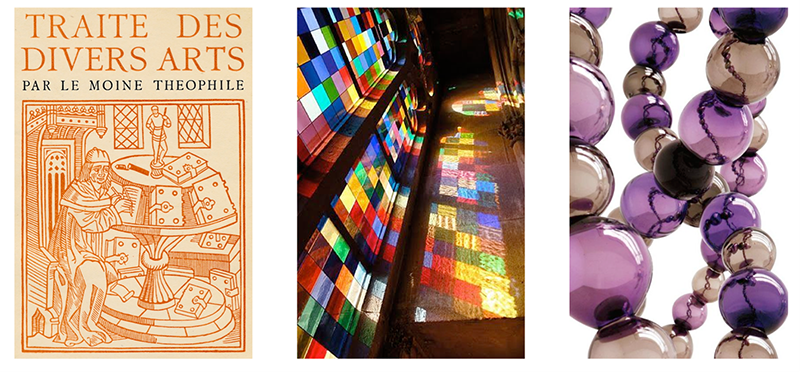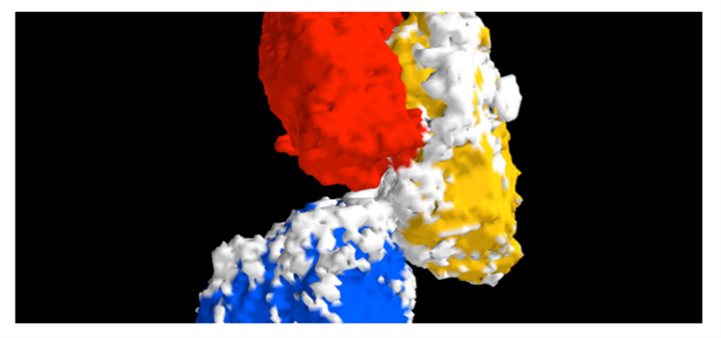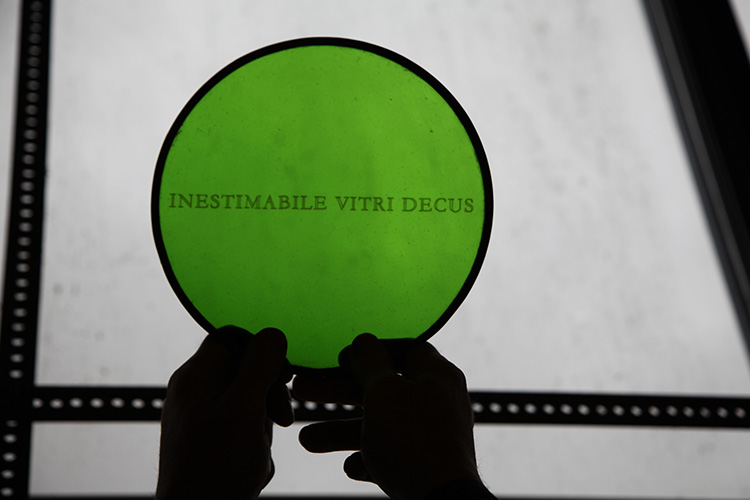The year 2022 has been declared the "International Year of Glass" by the United Nations General Assembly. To celebrate this, the artist Hernán Gabriel Pais - who is also a member of the SOLEIL’s teams - has created a first-of-its-kind work of art using the interaction between glass and synchrotron radiation. This work, "Inestimabile Vitri Decus", transposes the words of the medieval monk Theophilus, describing the priceless beauty of glass, on a stained glass using X-rays produced at METROLOGIE beamline.
The creation of this work is the result of a collaboration between Hernán Gabriel Pais and several SOLEIL’s teams. By combining traditional techniques with cutting-edge technology, light becomes the tool for the metamorphosis of glass.
A bridge through history
The Middle Ages saw the exponential development of stained glass in cathedrals thanks to ever larger openings in the walls, made possible by the evolution of architecture and in particular the ogival keystone. In the 12th century, in his treatise Schedula, the monk Theophilus (fig 1), with the expression Inestimabile Vitri Decus, praises the theme of the building "with walls of light", like the celestial Jerusalem of the Apocalypse, built of precious stones, and symbolically and mystically justifies the fascination produced by coloured stained glass.

Figure 1:
(left) Frontispiece of an edition of the Schedula of the monk Theophilus; (middle) stained glass window in Cologne Cathedral by G. Richter, 2007;
(right) Art and Mathematics, work by J.-M. Othoniel, 2019
Since Saint Augustine, light has been an indispensable component of the notion of beauty, embodying the Divine Mystery. Today, light is also a high-tech tool used by researchers - whether it is visible light or other wavelengths. Glass, on the other hand, is a remarkably translucent material that has inspired people, artists and researchers since its discovery 5000 years ago. From Abbé Suger and the Basilica of Saint-Denis to Jean-Michel Othoniel and his glass sculptures, from Pierre Soulages and the stained-glass windows of the Abbey of Conques to Gerhard Richter and the stained glass windows of Cologne Cathedral (figures 1 & 2), exploring the aesthetics of light shining through matter is an endless quest for the grail.

Figure 2:
(left) Rose of the Basilica of Saint-Denis, 19th century stained glass window;
(right) Stained glass windows of the Abbey of Conques, by P. Soulages, 1987-1994.
Glass has also become an essential technological material, an ally of researchers. From the end of the 16th century onwards, the improvement of its transparency allowed the development of the astronomical telescope and the optical microscope, thanks to which scientists began to examine the infinitely large and the infinitely small.
But the physical nature of glass is also remarkable. The amorphous nature of glass kept its atomic structure a mystery for a long time. Even today, the nature of the glass transition, marking the change from the liquid to the vitrified state, is one of the great problems of physics. Synchrotron light has enabled science to take a new look at the structure and properties of glasses. The pioneering experiments carried out more than 40 years ago at ACO, the synchrotron that preceded SOLEIL, using X-ray spectroscopy to study the structure of glass, the study of the glass melting mechanism in furnaces by Saint-Gobain using X-ray tomography (figure 3), or the study of the colors of medieval stained glass windows (https://www.synchrotron-soleil.fr/en/news/new-approach-browning-phenomenon-medieval-stained-glass-windows) are just some of the studies for which synchrotron radiation has provided valuable information for a better understanding of this material.
It is these multiple facets that the United Nations is celebrating by declaring 2022 the "International Year of Glass".

Figure 3: X-ray tomography image of the melting of glass raw materials. © Gouillart et al. JACS, 2012.
Genesis of the work
The artist Hernán Gabriel Pais aims, through a simple and symbolic gesture, to draw a line between the stained glass windows of medieval cathedrals and a place where the most modern science is carried out thanks to light: the synchrotron. The idea for his project came from his interactions with Myrtille Hunault, scientist at the MARS beamline. Myrtille studies the conditions for analysing precious samples such as heritage objects with synchrotron radiation, without them being damaged or modified by this radiation. Hernán Gabriel Pais' idea was to use the trace left by synchrotron radiation to invent a new aesthetic. He wanted to create a modern stained glass window in which the glass would be marked by the light of science. In the shape of a disc, recalling the shape of the synchrotron, the sun, but also the host, this stained-glass window is presented in a showcase like a relic. With this work, Hernán Gabriel wants the public to travel through time and space: from Antiquity to the 21st century via the Middle Ages, and from the stars that light us to the earth where we draw the sand to make glass, he wants the public to meet cutting edge science through the prism of art.
A technical challenge
To create this work, it was first necessary to find the optimal conditions for irradiating the glass with the synchrotron beam so that the glass is marked. The intensity and tint of the mark depends on the chemical composition of the glass; the chemical composition of the glass also determines its colour. The tests made it possible to select the glass that gave the best result. This was prepared by the Vitrail France workshop, which is also involved in the restoration of the stained glass windows of Notre Dame Cathedral in Paris, and which also took care of the lead framing of the glass at the end of the project.
Initial "photo-writing" tests were carried out on the PUMA beamline, using a monochromatic (single wavelength) X-ray beam. Then the work was finally carried out on the METROLOGIE beamline, this time with a polychromatic X-ray beam, i.e. covering a range of wavelengths, still in the X-ray range – so that there is more flux, i.e. a greater quantity of X-ray photons in the beam, and the 'photo-writing' is faster.
Next, the motorised system and its complex two-dimensional trajectory control had to be developed to enable moving the glass disc in the beam and trace perfectly each letter, one after the other. This development, carried out by SOLEIL's Acquisition and Control Systems Engineering team, is based on the use of high-performance controllers (PowerBricks), which made it possible to create the specific trajectory for writing the phrase Inestimabile Vitri Decus.
After all the preparatory work done on PUMA, less than ten trials (and therefore glass discs) were necessary on METROLOGIE to obtain the final result - it is indeed impossible to erase the glass once it is marked! Each trial, i.e. each writing of a sentence, took about 30 minutes.
The work is now on display in the hall of the central building of the SOLEIL site.

Figure 4: The final work, the photo-marked and leaded glass
